Trumpeter 1.32 F4F-3 – Butch O’Hare
The F4F‑3 "Wildcat" was the outcome of a development process by Grumman in response to a 1938 U.S. Navy requirement for a replacement for the F3F series. The Navy - while desiring a monoplane fighter that would be close in performance to its land‑based opponents - was also conservative in its planning; Grumman, the company that had created the F3F, was asked to create another biplane fighter ‑ the XF4F‑1 ‑ while Brewster would build a monoplane, the XF2A‑1. Grumman saw correctly that the biplane was a dead‑end, and managed to convince the Navy that with a few modifications, the F3F‑2 could meet the requirements of the XF4F‑1; this was ordered into production as the F3F‑3, and Grumman was able to proceed with its own monoplane design, the XF4F‑2.
How it was that the XF4F‑2, designed and built by the Navy's premier fighter design company, lost out to the XF2A‑2 ‑ the first aircraft design of a company primarily known for building horse‑drawn buggies, a company with no experience of aircraft production or possessed of the facilities to do so ‑ is one of those bureaucratic mysteries that has never been fully explained, the moreso since both aircraft were so close in performance that they were twins.
Luckily for the Navy and history, Grumman convinced the Bureau of Aeronautics to allow them to rework the design a third time, to create the XF4F‑3. This fighter was a marginally‑better performer than the F2A‑1, which had just entered production; Brewster was already demonstrating its inability to meet any production schedules, and the Navy was glad to be able to order the new fighter from the more reliable company.
The first production F4F‑3 was flown in February 1940, powered by a Pratt and Whitney R‑1830‑76 Twin Wasp with a two‑stage supercharger, with the second following that July. These and the next eight F4F‑3s were involved in tests by the Navy to change the cooling flaps and exhaust to get rid of exhaust seepage in the cockpit and to improve engine cooling. In April 1940, due to fears of production delays with the two‑stage supercharger, the Navy asked Grumman to change the airplane to use the R‑1830‑90 Twin Wasp with single‑stage supercharger.
This emerged as the F4F‑3A, 55 of which were given to the Marines in 1941, since they had shown they did not have the necessary high‑altitude performance with the single‑stage supercharger. AVG ace Charles Older once told me that one of the reasons he volunteered for the AVG was that he didn't want to go into combat in the F4F-3A after once losing a “dogfight” with a USAAC P-40C in early 1941.
The last 100 F4F‑3s were changed to use the R‑1830‑86 Twin Wasp with a two‑stage supercharger; these were visually different from the early F4F‑3s and F4F‑3As by the absence of the intake on the upper cowling, that having been moved inside the cowl, and the presence of additional cowling flaps.
VF-41 became operational with VF‑41 aboard the "Ranger" on December 4, 1940. VF-41 was followed soon after by VF‑42 aboard “Yorktown,” followed closely by VF‑71 and VF‑72 aboard the "Wasp" in February 1941. VF‑6 turned in their F3F‑2s for F4F‑3s in June 1941, while VF‑3 exchanged their F2A‑1s for F4F‑3s in October 1941, as did VF‑5. VMF‑121 and VMF‑211 were equipped with F4F‑3s while VMF‑111 flew the F4F‑3As. In November 1941, the airplane received the emotive name "Wildcat."
The first F4F‑3s to see combat were the 12 Wildcats of VMF‑211 at Wake Island. All but four were lost the first day; during the next two weeks those four were kept operational by cannibalizing the wrecks. The Wildcats turned back several Japanese bombing raids from the Marshall Islands, and even sank a destroyer during the first invasion attempt, which was turned back. The carriers "Hiryu" and "Soryu" were detached from the returning Pearl Harbor strike force to support the invasion of Wake. On December 22, the last two Wildcats were written off in landings after suffering damage in combat with Zeros. The next day, the Marines on Wake were forced to surrender in the face of overwhelming odds.
The F4F‑3 next saw action in early February when the "Enterprise" and "Yorktown" - with VF‑6 and VF‑42 respectively embarked - struck the Marshall and Gilbert Islands. In the meantime, VF‑3 aboard the "Lexington" was about to see action that would test the theory that "the bomber will always get through" and that carriers could not withstand a determined attack by land‑based air forces.
"Butch" O'Hare Saves The "Lexington":
Edward H. "Butch" O'Hare graduated from the U.S. Naval Academy in 1937. After two years of sea duty aboard the U.S.S. "New Mexico," he was sent to Pensacola in 1939, becoming a Naval Aviator in May, 1940. He was assigned to VF‑3, which was then aboard the "Saratoga" and finally getting their full equipment of the F2A-2.
LT. John Thach, Executive Officer of VF‑3, saw O'Hare's exceptional abilities as a fighter pilot, and took him as his wingman. Thach emphasized gunnery in his training ‑ as did every USN Fighter Squadron XO (unlike their Army compatriots). O'Hare was a standout. At the fleet gunnery competition in November 1940, eight of 16 VF‑3 pilots qualified for the covered "Gunnery E," and O'Hare won the fleet trophy for best gunnery.
On February 20, 1942, "Lexington" approached New Ireland from the north to strike Japanese shipping at Rabaul. 400 miles from the target, the task force made a radar contact 35 mules out. Squadron CO Thach led the first division off for intercept, with the second 4‑plane section under Squadron XO LCDR Don Lovelace orbiting the task force. Vectored in and out of clouds and squall lines, Thach's division finally found an H6K Mavis hiding in a rain squall. While his wingman made a portside high overhead pass, Thach came in on a starboard overhead pass. Their combined fire lit the fuel tanks of the big "Mavis," which spun into the ocean. 50 minutes later, two other Wildcats of Lovelace's division splashed a second "Mavis," but it was clear the task force had been discovered. "Lexington" was about to find out if a carrier task force could stand up to a determined land‑based bombing attack.
At 1630, 17 G4M1s of the 4th Air Group approached from Rabaul in two formations ‑ one 9‑plane formation from the starboard side, one 8‑plane formation from port. Each “Betty” was armed with two 550‑lb armor‑piercing bombs. The Japanese were 25 miles from the task force when radar picked up the eight planes of the first formation. The timing could not have been worse for "Lexington," as LCDR Lovelace's division had just entered the landing pattern after the launch of the relief CAP under LT Noel Gaylor.
The Japanese formation flew over the task force and turned to attack from astern, losing precious minutes. Lovelace's division, flying on their last few gallons of fuel, hit the Bettys as a unit and disrupted the bomb run ‑ the nearest explosion was 3,000 yards from "Lexington."
Gaylor's division lost two Wildcats to the 20mm tail stingers of the "Bettys," and Thach was launched again with a six‑plane CAP that included O'Hare. As Thach and three others hit the Bettys ‑ Thach shot down two ‑ the last two members of the CAP were ordered to orbit the ship.
O'Hare and Lt.(j.g.) Marion Dufilho felt frustration as they watched the rest of the CAP chase away the surviving Bettys. At this moment, 16 of the squadron's 18 aircraft were committed to the battle.
A few minutes later, at 1700, "Lexington" picked up the second formation on its CXAM radar, only 12 miles out on the disengaged side of the task force, completely unopposed. O'Hare and Dufilho were ordered to "Buster" - maximum speed. The climbed as fast as the relatively-sluggish F4F-3 could, and arrived 1,500 feet above the attacking Bettys when the formation was only 9 miles out. The two rolled into a starboard high‑side pass as the Bettys descended in a fast shallow dive toward "Lexington."
As O'Hare lined up his first target, Dufilho dove away with jammed guns. The Fleet Gunnery Competition was about to enter the only match that counted.
Tracers from the nine bombers streaked past as he closed to a range of 100 yards and took aim and opened fire at the starboard engine of the last plane in the V of V's. The hits were so concentrated that the engine on the Betty literally jumped out of its mountings. As the first victim spun down, O'Hare hit the second target with another concentrated burst. As he pulled out, he came up on the last Betty on the other side of the V and blew up its port engine. Turning into a second pass, he hit a fourth Betty.
Thach later reported that at one point he saw three bombers falling in flames at the same time as he and his section joined the fight. O'Hare made a third high‑side pass, diving through the flak bursts from "Lexington's" anti‑aircraft fire as every surviving Japanese bombers opened fire. O'Hare blew up the formation leader as his guns rattled empty.
The four surviving Bettys placed their bombs within 100 yards of "Lexington's" stern. Thach's four Wildcats intervened at that moment and shot down two of the survivors.
The value of the Navy's emphasis on gunnery training for its fighter pilots had been more than fully demonstrated. When O'Hare climbed out of his cockpit upon landing, his first request was for a glass of water; he downed four before leaving the flight deck. Against the loss of two F4Fs and one pilot, VF‑3 had downed fifteen of seventeen attackers, including two that ditched on the way home. It has later been determined that O'Hare only shot down four of the attackers, though a fifth was one of the two that ditched, validating his claim. Afterward, Thach determined O'Hare had used only 60 rounds for each plane he destroyed.
Having probably saved the "Lexington" in this fight, Edward H. "Butch" O'Hare became the first Naval Aviator of the Second World War to win the Medal of Honor, and the only one of eight Wildcat pilots to win this honor who was carrier‑based.
When he completed his tour of the U.S. to sell war bonds after being decorated at the White House, O'Hare rejoined VF‑3 in 1943 in Hawaii. There he met a young Naval Reserve Ensign just out of flight school who showed the same kind of promise O'Hare had shown Thach. LCDR O'Hare made ENS Alex Vraciu his wingman, and taught him everything he knew, taking Vraciu with him when he was given command of VF‑6.
On November 27, 1943, during an experimental night interception mission over the Gilbert Islands, O'Hare was lost in circumstances which have never been fully explained.
Alex Vraciu demonstrated he had learned well as he went on to become the top ace of the Navy by the second anniversary of O'Hare's mission of February 20, 1942, ending the war as the fourth‑ranked Navy ace. To this day, he will tell anyone who asks (as I did 14 years ago) that "Butch O'Hare was the greatest fighter pilot and the best officer I ever knew."
Today, if you visit the Main Terminal at O'Hare International Airport in Chicago, you can see an F4F‑3 retrieved from the depths of Lake Michigan, restored as the Wildcat Chicago's son flew on that memorable mission. It is the centerpiece of the terminal.
The Kit:
Incredibly, Trumpeter's F4F-3 is the first early Wildcat released by any mainstream manufacturer that is actually an F4F-3. Hasegawa's 1/72 F4F-3 is their F4F-4 kit with different decals, and requires considerable modification to turn it into an F4F-3. In 1/48,the only way to create an F4F-3 was to use either an early conversion from KMC that is now long out of production, or a resin conversion from Just Plane Stuff which I reviewed here in MM several years ago.
The kit is not merely a modification of the earlier F4F-4 kit. Trumpeter has produced a different, corrected cowl for the late production F4F-3, as well as completely changing the wing to the non-folding wing of the earlier Wildcat, including the very different armament set-up, and changing the panels on the rest of the wing. The kit also provides the different pitot tube and the smaller tail wheel fairing and tail wheel.
The only “mistakes” made are that the windscreen does not have the additional framing in the side panels, and that the drop tanks of the F4F-4 are still included and the instructions say to use them. The additional framing is easily done when masking the canopy for painting, and the drop tanks would be right if one were to modify this kit to the unarmed F4F-7 long range photo reconnaissance airplane.
Decals are included for an F4F-3 of VF-6 aboard “Enterprise” in February-April 1942, with larger insignia overpainted and superimposed on the earlier, smaller insignia. The red and white stripes provided on the sheet are specific for this airplane only, since stripes on VF-6 aircraft were non-standard and varied from airplane to airplane. If a modeler decides to do an airplane from another squadron (as I did) then the rudder will have to be painted to get the correct number of stripes. The other airplane is one of the last F4F-3s to see combat, flown by MAJ Robert Galer of VMF-224 at Guadalcanal in October-November 1942. Unfortunately, the decals live down to Trumpeter's previous low standards for decals, and are best tossed. Fortunately, Yellow Wings Decals will soon release a sheet for the late-production Wildcat, following the pending release of decals for the upcoming early-production F4F-3 release.
Regarding the VMF-224 airplane in the decals, my good friend Erik Whipple told me, “Fritz Payne told me at an AFAA reunion that he often flew #2 with the red cowl ring and was positive enough about it to autograph the photo in my Osprey Wildcat Aces book. He also said that it did not have kill marks on it and confirmed that the plane was eventually grounded and then became a photo prop with Jap flags.” One has to wonder how many “aces' airplanes” known in history are actually “photo props.” I can think of “Marion Carl's Wildcat” which I reviewed here a few years ago, which Carl told me was a hangar queen sitting on Espiritu Santo on which he and a Gunnery Sergeant stuck a bunch of victory stickers so he could pose with “his” airplane for the press and be photographed for history.
Construction:
One thing struck me at the outset with this kit. Back three years ago when I first built an F4F-4, I thought the surface detailing was incredibly heavy. This time, in the wake of experiencing the latest extreme example of Chinese overdone surface detail on the Dragon P-51D, I felt like I had to search to find the much lighter surface detail here! I compared the completed model with my other two Wildcats (F4F-4 and Wildcat V) and in fact the surface detail is the same on all three. While this detail is not really right - the Wildcat only had flush riveting on the leading edge of the wings back to the main spar, and the panels on the fuselage were lapped (as all correctly done on the Tamiya 1/48 Wildcat), the surface detail here is acceptable and looks all right in the end after the model is painted.
This kit reveals its early origins with the photo-etch hinges for the control surfaces, which I again ignored. I assembled the ailerons, elevators and rudder, and filled the slots with Evergreen sheet.
I then assembled the wings and attached them to the separate fuselage halves before proceeding with further assembly. This allowed me to work the wing-to-fuselage joint from both sides, pressing the wings to the fuselage and getting a good join so that I did not have any gaps and didn't need any filler. One thing I did not notice until the model was finally painted is that the main gunbay cover is not very smooth overall; it ended up looking “lumpy,” but at that point I didn't want to strip the paint, fill the panel smooth, rescribe and then repaint since the final painting would not have matched the surrounding area and that would (to me) have looked worse. I recommend you assemble this panel, put on a thick coat of Mr. Surfacer, sand it smooth and rescribe the area as necessary at the assembly stage. The result will be improved.
I then proceeded to assemble the cockpit. Trumpeter's painting instructions are wrong. The cockpit of Grumman-built Wildcats was Bronze Green, not Interior Green. I used Tamiya XF-5 Flat Green for this color. Also, the entire instrument panel bulkhead and the entire side panels should be black according to the color photographs of the correctly-restored F4F-3 at the National Museum of Naval Aviation, which are in “F4F Wildcat in Detail and Scale.” I had a decal for the F4F-3 panel on an old Pro-Modeler sheet which was far too big for the 1/48 it claimed to be, but was the exact right size for 1/32, and I used this instead of the panel and film provided by the kit. I made lap belts (F4F-3s did not have shoulder harnesses) from lead foil.
Assembly of the cockpit and the fuselage was not easy, due to poor molding of the fuselage halves. I suggest you take the bulkhead for the wheel well and glue it solidly to one or the other fuselage halves - I superglued mine in position - to get the fuselage squeezed into the right shape. Once that is done, this becomes the cornerstone for further assembly. I then assembled the engine mount and landing gear upper assembly in position. While that set up I attached the rest of the cockpit in position. When that had set up, I glued the fuselage halves together. This took some industrial-strength pushing and shoving to get the forward fuselage to fit together right, and I superglued the forward seam ahead of the cockpit to get it right, then proceeding to glue the lower fuselage seam, and then the fin (which was also a bit warped),ending with the fuselage spine. I ended up using a considerable amount of Mr. Surfacer 500 on the centerline seam, with a lot of sanding, and then rescribed the panel lines.
I next glued the firewall to the forward fuselage, and then moved from there to attach the very nice R-1830 engine after assembling it, and then attached the cowling.
Since the landing gear of the Wildcat I was going to do was all painted in the lower surface color of light grey, I attached the landing gear at this point rather than wait till after painting as I did with the F4F-4 and Wildcat V models. You should be aware that F4F-3 landing gear could be overall light grey, or black on the folding parts. You can check this photographically for the particular F4F-3 you are doing.
I finished off the assembly by attaching the ailerons and elevators and set the model aside for everything to fully set up.
Painting:
I preshaded the model by airbrushing flat black over all the panel lines. I then painted the lower surfaces with Xtracrylix “Light Gull Grey.” The upper surfaces were painted with Xtracrylix RAF PRU Blue, which was an almost-exact match for the Dark Blue Grey as shown in the color photograph on the cover of the Detail & Scale book. I lightened this with Xtracrylix “Dark Blue Grey” - which is actually too light unless you are doing a very faded surface - and post-shaded the upper surface. I then added in some Xtracrylix “White” and thinned the paint 75% with thinner, and applied this over the multi-hue coloration, to get a sun-faded look to the upper color.
The rudder was painted with Tamiya Flat white, masked off, and those stripes painted with Gunze-Sangyo Flat Red tinted with black to make the same shade red as the Yellow-Wings decals I was going to use.
When all this had dried, I gave the model an overall coat of Xtracrylix Gloss Varnish.
Decals:
I came up with these markings using various sheets in the decal dungeon. The national insignia came from the Yellow Wings 1/32 National Insignia sheet, while the individual markings were done from a SuperScale letter-and-number sheet. I was doing these markings from a photograph in the Squadron “Wildcat in Action” book, of Butch O'Hare in a Wildcat with small VF-3 insignia and five small Japanese flag markers. “F-3" is definitely not the airplane O'Hare flew on February 20. There is a famous photograph that is allegedly of Thach in “F-1" and O'Hare in “F-13", and there is information that he was flying “F-15" on the MoH mission. “F-3" may well have been his “assigned” airplane in the squadron. It might also have been a “hangar queen” at Ford Island that had the squadron insignia painted on and the flag stickers applied for publicity purposes, as was the case with “Marion Carl's Wildcat” described earlier. Whatever the case, I had decals in the dungeon to do the markings of this airplane, which is at least historically “an F4F-3 Butch O'Hare sat in at least once with his kill markings on it.” Again, as Erik Whipple says, “Too bad the pilots didn't realize that although there was a war on it would have been a great benefit to modelers if they had taken photos only with the planes they actually flew as follows: one with the plane in full view, one in the cockpit for glamour, and another standing on the tail pointing at the BuNo - with a date card at the bottom corner of each. So much argument could have been averted. I've always respected the men and women of WW2 long before Mr. Brokaw started calling them The Greatest Generation. I just wish they'd have recognized the researcher's nightmare they were creating on their way to victory. Tsk, tsk.”
Final finish and Assembly:
When the decals were set, I gave the model several coats of Xtracrylix Flat Varnish. When that was dry, I unmasked the canopy, applied light exhaust staining to the lower fuselage, and attached the wheels, pitot tube and navigation lights.
Conclusions:
Trumpeter's F4F-3 makes up into the most accurate model of the late production early Wildcat currently available. The kit presents no real difficulties in assembly (if you follow my procedure for assembling the fuselage), and looks very good when complete. It looks particularly good sitting next to my Trumpeter SBD Dauntlesses. For those who like the Wildcat, this is a long-awaited addition to what can be made. The model could also be completed as a Fleet Air Arm Martlet III in desert camouflage.
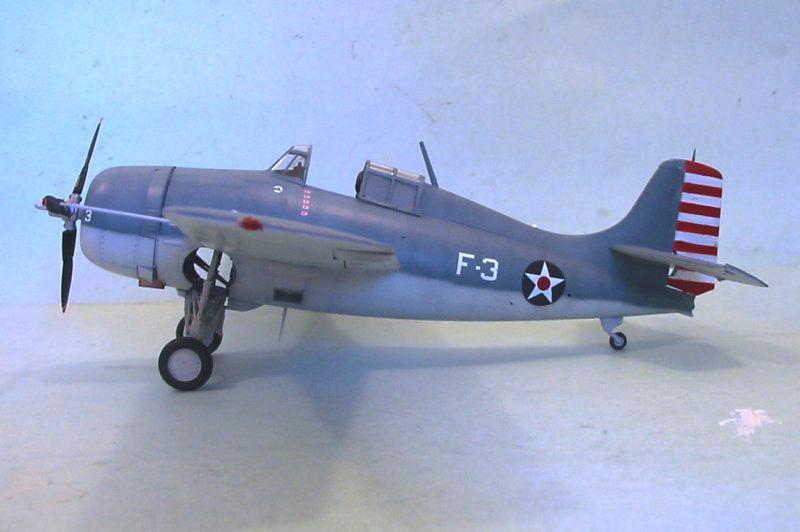
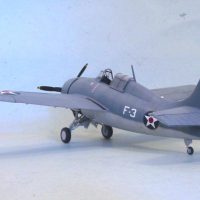
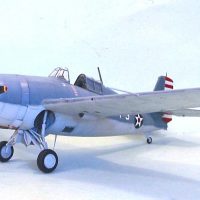
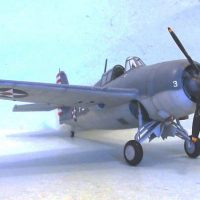
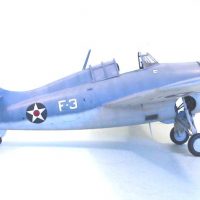
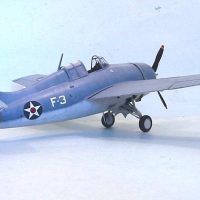

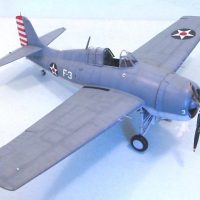
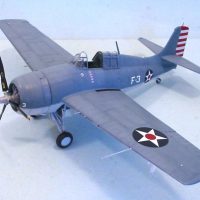
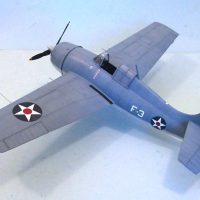
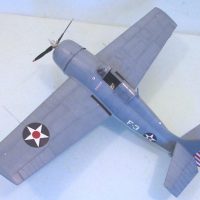
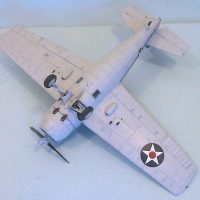
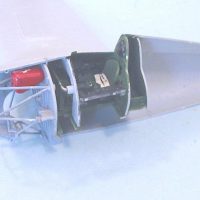
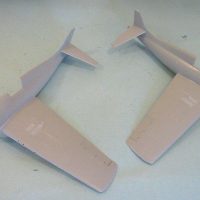
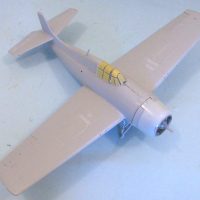

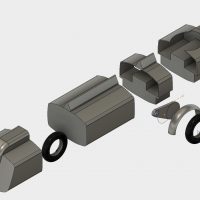
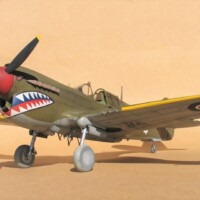
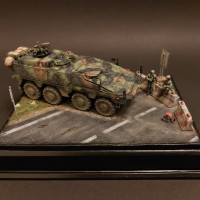
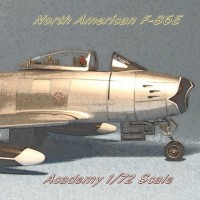
Hi Tom,
Great job on the Wildcat, I've read your review and construction tips on this Trumpeter kit quite a while ago, which led to my purchase of it just as I was starting back up in modeling, just before Covid got all our attention. Bert Kinsey does an excellent job with his in detail & scale series which you mentioned. I plan on starting it soon!